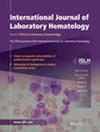Concentration Estimation of Apixaban and Rivaroxaban in Plasma From Patients Through Heparin-Calibrated Anti-Xa Assay Generated Different Results by Using 3 Reagent/Calibrators/Instrument Systems
Abstract
Background
Direct oral anti-Xa inhibitors are widely used in thrombosis treatment or prophylaxis. Despite the high safety profile, in clinical practice, the measurement of drug concentration in plasma is sometimes needed.
Objective
The aim was to compare results of three branches of reagents/calibrators/coagulometers for Heparin Calibrated Anti Xa assays (HC-Anti Xa) in samples from patients taking apixaban (APIXA) or rivaroxaban (RIVA).
Methods
Population: 49 samples from patients receiving APIXA (32–703 ng/mL) and 40 receiving RIVA (< 8–573 ng/mL) taken at peak or trough. RIVA and APIXA measurement: HemosIL Liquid Anti Xa (Werfen) in ACL TOP 300 and STA-Liquid Anti Xa in STA Compact Max (Stago) with specific calibrators. HC-Anti Xa activity (1) HemosIL Heparin (Werfen) in ACL TOP 300; (2) Innovance Heparin (Siemens) in Sysmex CS-2500 (Siemens Health Care); (3) STA-Liquid Anti Xa (Stago) in STA COMPACT MAX coagulometer.
Results
HC-Anti Xa values paired compared showed statistically significant differences between the three systems, with the highest values obtained with the Stago system. An r 2 > 0.94 was found for Werfen and Siemens with samples with any drug, but r 2 of 0.800 for APIXA and 0.792 for RIVA was observed in the Stago System due to a tendency to plateau at high drug concentrations. Analyzing only samples with concentrations ≤ 200 ng/mL, an r 2 > 0.93 with the three systems in APIXA (n = 30) samples and 0.913, 0.875, and 0.906 in RIVA (n = 31) samples with Werfen, Stago, and Siemens systems, respectively. Important differences inter systems in HC-Anti Xa calculated from regression lines were observed at 30, 50, 75, and 200 ng/mL of both drugs. Drug concentration measured by the Anti Xa assay calibrated with specific calibrators in 45 samples with APIXA and 27 with RIVA in Werfen and Stago systems showed very good correlation (r 2 = 0.991 and 0.976, respectively).
Conclusion
Estimation of APIXA or RIVA concentration through HC-Anti Xa is possible, but values obtained are different for each reagent/calibrator/instrument system. Knowledge of the HC-Anti Xa values corresponding to anticoagulant concentrations at clinical decision points in the system used by each laboratory is mandatory to be able to use them correctly in the clinic.

 求助内容:
求助内容: 应助结果提醒方式:
应助结果提醒方式:


